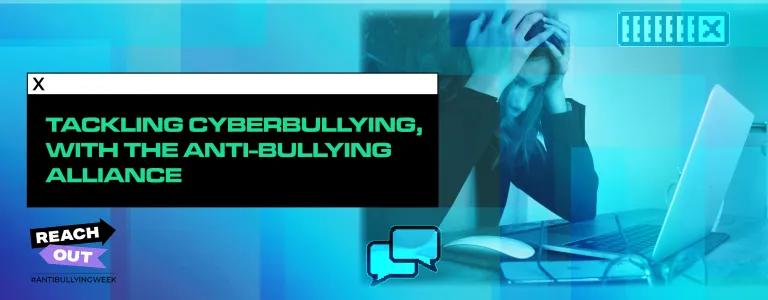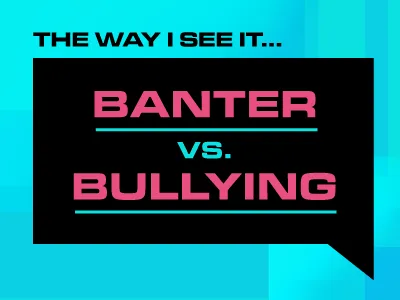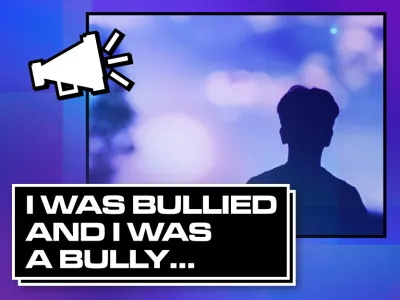
Tackling Cyberbullying, With The Anti-bullying Alliance
It’s Anti-Bullying Week. Set up by the Anti-Bullying Alliance, the week aims to challenge and stop bullying. The theme for this year is Reach Out, which empowers people to do something positive to counter the harm and hurt that bullying causes. We caught up with the Anti-Bullying Alliance to talk about cyberbullying; what it is, how it happens and what you can do about it. Here’s what they had to say…
What is cyberbullying?
Cyberbullying is any form of bullying that is carried out through the use of electronic media devices, such as computers, laptops, smartphones, tablets, or gaming consoles.
Whilst cyberbullying isn’t as prevalent as face to face bullying, there are some things that make online bullying different to 'traditional' bullying and challenging to address. This includes:
- As it’s in our smart phones, it’s with you all the time. So it’s hard to get away from it.
- People bullying you are able to hide their identity which can be quite scary for those experiencing it.
- People who cyberbully also often don't see the reaction of those experiencing it so it can sometimes be harder for them to see the impact of their actions.
Approximately 24% of children and young people will experience some form of online bullying and 17% of children and young people admit to bullying others online. Name calling is the most common type of online bullying.
Some research from Warwick University in 2017 showed that there is a strong link between face to face bullying and online bullying. It found that 80% of victims of online bullying were also bullied face to face.
Why does it happen?
Anyone is capable of displaying bullying behaviours and there is not a significant amount of research relating to the common behaviours that children who bully, exhibit but research shows that children who bully are more likely to:
- Find challenges to their self-esteem difficult to handle
- Show moral disengagement, separating themselves from the impact of their actions or minimising their role
- Have lower empathy
- Have poorer communication with parents and experiencing bullying from family members
- Be seen by others as powerful and having high status
- Have poor well-being themselves
What does cyberbullying actually look like?
Through combined research findings, several distinct behaviours have been identified which typify the types of incidents cyberbullying victims are likely to experience. These include:
- Written or verbal attacks
- Threats of physical violence (including towards a person’s family or property)
- Name calling
- Denigration (putting some down in front of others)
- Cyberstalking (following someone without their knowledge)
- Masquerading (pretending to be someone different or setting up fake profiles)
- Exclusion
- Prank or silent phone calls
- Outing (posting personal information without consent)
- Impersonation (stealing someone’s password and pretending to be them)
- Flaming (intentionally starting fights)
- Rumour spreading
How can we tell the difference between banter and bullying? And what steps can we take to stop it?
We often hear people refer to behaviours that are bullying as ‘just banter’. It is really important we have a shared understanding of what bullying is and isn’t to avoid us misidentifying it. Our definition of bullying is:
“The repetitive, intentional hurting of one person or group by another person or group, where the relationship involves an imbalance of power. It can happen face to face or online.”
When you are confronted with the decision ‘bullying or banter?’ think carefully about the power relationship between the parties. Has the person experiencing it said they don’t like it? Does it involve numerous people? Does it target an aspect of their appearance or personality?
Banter involves people with equal power, where there is no hurt involved and no intent to cause harm. In no way are we saying that people can’t make jokes, but just be aware of crossing the line.
What can someone who is witnessing or being targeted by cyber bullies do?
If a young person is experiencing cyberbullying, the most important thing they can do is tell someone about it and remember that it is NOT their fault. Our advice is:
- Tell an adult you trust
- Keep evidence by saving any digital content or taking screenshots
- Block abusive users
- Regularly change passwords and don’t share passwords with others
- Follow the procedures for reporting abusive content on social networks
Are there ways to avoid or prevent cyberbullying?
Making use of the reporting and blocking tools available on social media platforms is a way of removing and preventing any negative communications online and preventing cyberbullying from happening in the future. However, the best way to prevent cyberbullying is to be kind to yourself and others. Remember to respect other people! Just because someone is different to you and your friends doesn’t mean you are better than them, or have a right to make them feel bad. If you mess up, say sorry. You don’t have to be friends with everyone, but you should always make it clear that you don’t like it when people bully others and stick up for people who are having a hard time.
When does cyberbullying turn into a crime? And what can you do?
There is no legal definition of online bullying within UK law and most cases of bullying do not count as a crime. However, when bullying has gone too far online, there are a number of existing laws that can be applied to cases of online bullying and online harassment. If you think the bullying you have experienced would count as a crime, it’s really important you speak to an adult you trust and/or call Childline or your local police.
What should someone do if they think they are cyberbullying someone else?
If you’re worried you are bullying someone online, think carefully about your intentions and how it might make someone feel. Consider ‘if someone treated me like this, would I be upset?’. If it’s playing on your mind, chances are that you are saying or doing things that you know could be hurting someone. Remember it’s never too late to change your behaviour and say sorry.
What is the Anti-Bullying Alliance and how can young people support Anti-Bullying Week, and beyond?
The Anti-Bullying Alliance is a coalition of over 200 organisations united against bullying. We are based at a children’s charity called the National Children’s Bureau.
We would love to see lots of young people getting involved in Anti-Bullying Week – whether it be putting on your odd socks for Odd Socks Day, joining in with Anti-Bullying Week activities at your school or college, or perhaps even organising your own Anti-Bullying Week event, fundraising or activity.




